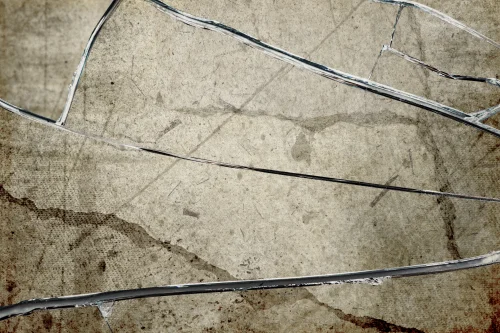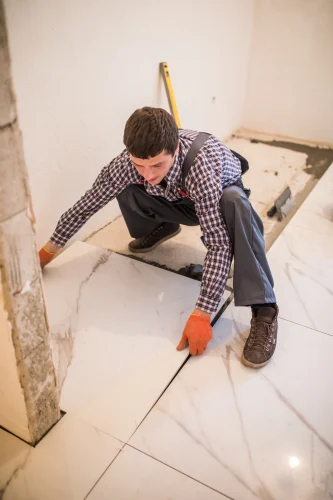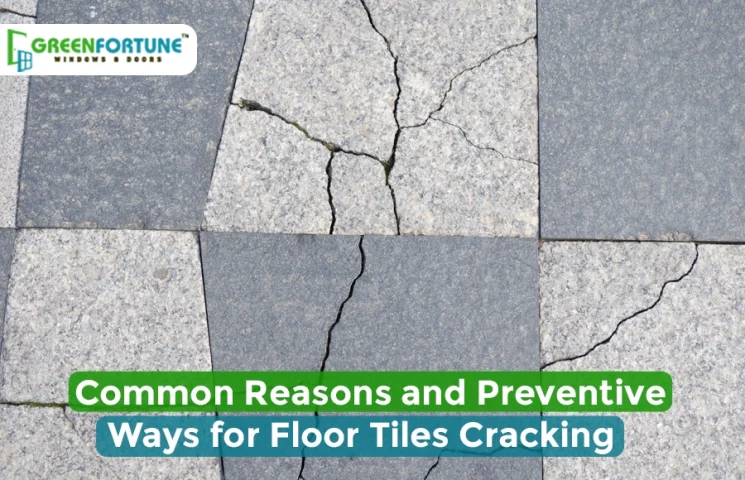
Difference between porcelain and ceramic tiles? Which one to choose?
February 15, 2025
How to Paint Your Floor Tiles And Give Them a Fresh Look
February 15, 2025Floor tiles cracking is a common problem among homeowners and builders in India. Factors such as inappropriate installation, low quality materials, and environmental factors lead to this problem. For example, a sudden crack in the floor tiles of a government place in Tamil Nadu recently caused fear among staff, showcasing the value of adequate tile installation and maintenance.
In this blog, we will see the common causes behind floor tiles cracking and provide practical solutions to prevent such occurrences.
Let’s get started!
What Causes Floor Tiles to Crack?

1. Poor Subfloor Preparation
A weak or uneven subfloor is one of the biggest culprits behind floor tiles cracking. When the base beneath the tiles isn't strong or level, it creates pressure points, leading to cracks over time. This is a common issue in high-rise buildings, where poor subfloor work can degrade the entire flooring system.
The answer to long-lasting, crack-free tiles lies in real subfloor preparation. A well-leveled and stable base provides linear support and prevents pressure on the tiles.
How to Achieve This?
To ensure a strong foundation and prevent cracked floor tiles, follow these essential steps:
- Use high-quality screed – Opt for a durable screeding material that provides a stable, smooth surface.
- Check for moisture – Excess moisture weakens adhesives and causes tiles breaking over time. Ensure the subfloor is completely dry prior to installation.
2. Heavy Impact or Load
Tiles are outlined to withstand regular foot congestion, but uncontrolled weight or unforeseen impact can break floor tiles. Releasing heavy objects, moving furniture without correct protection, or placing overweight machines on tiles can erode them over time. In merchandise spaces, brittle tiles can crack due to uninterrupted pressure from high foot traffic.
The easy way to stop cracked floor tiles is to choose tiles based on the expected load and footfall. Using tiles with the correct thickness and durability for each space guarantees durability and long-term cost savings. Setting up inappropriate tiles in high-pressure zones is a common error that leads to early tile failure.
How to Achieve This?
To prevent tiles breaking under pressure, follow these steps:
- Select high-quality tiles – Go for burnished or porcelain tiles that can wither high impact.
- Contemplate thickness – Tiles in high-footfall areas should be at least 10-12mm thick to resist cracking.
You can also give a read: How to Choose Best Coloured uPVC Windows for Your Home
3. Temperature Variations and Expansion Gaps
Tiles naturally expand and contract due to temperature changes. In regions with extreme climate variations, the constant shifting can create internal stress, leading to cracked tiles. This is particularly common in outdoor spaces, balconies, and large tiled areas where insufficient spacing between tiles restricts movement.
Allowing room for tile expansion is the key to preventing tiles breaking due to thermal stress. Expansion gaps act as buffers, absorbing movement and reducing the chances of cracks forming over time.
How to Achieve This?
To prevent cracked floor tiles caused by temperature changes, follow these steps:
- Install expansion gaps – Leave a 1.5-3mm gap between tiles to accommodate movement.
- Use flexible adhesives – Choose adhesives with elasticity to absorb minor tile shifts.
4. Poor Quality Tiles or Installation Mistakes
Utilizing low-quality tiles or having them inappropriately can lead to a broken tile floor much sooner than anticipated. Cheap tiles often have weak structural ethics, making them prone to cracks under minimal pressure.
Investing in better-quality tiles and executive installation guarantees a durable, long-lasting floor. Better-grade tiles are outlined to wither wear and tear, while specialized installation prevents common issues like uneven surfaces, loose tiles, and inappropriate bonding.
How to Achieve This?
To avoid cracked tiles caused by poor materials or installation, follow these steps:
- Select high-grade tiles – Go for burnished or porcelain tiles with high strength.
- Certify proper grouting – Use better-quality grout to fill crevices and check moisture seepage.
4 Ways to Prevent Floor Tiles from Cracking

1. Choose High-Quality Tiles
The power and quality of tiles play a major role in averting floor tiles cracking. Low-cost tiles may seem like a budget-friendly selection, but they lack longevity and crack under pressure. Investing in better-quality tiles guarantees a longer lifespan and lowers the need for multiple replacements.
Going for strong, durable tiles presents both operational and aesthetic values. Better-grade tiles withstand wear and tear, making them perfect for high-traffic zones.
How to Ensure?
To ensure durability and prevent tiles breaking, follow these steps:
- Choose tiles with high load-bearing capability– Select Burnished or porcelain tiles that wither heavy resistance.
- Go for scratch-resistant tiles – This helps maintain the surface’s appearance and structural linearity.
2. Ensure Proper Subfloor Preparation
A stable and well-prepared subfloor is essential to prevent floor tiles cracking. If the base beneath the tiles is uneven, weak, or improperly set, it creates pressure points that lead to cracks over time. Inadequate subfloor preparation is one of the most common reasons behind broken floor tile issues, especially in newly constructed homes.
A strong, level foundation guarantees the longevity of tiles by segregating weight properly. Actual subfloor preparation discards tiles from shifting, cracking, or developing hollow spaces that can weaken their construction. Utilizing time in a well-prepared subfloor irradicates future repair costs.
How to Ensure?
To prevent cracked floor tiles due to subfloor issues, follow these steps:
- Level the subfloor – Ensure a smooth and even surface before laying tiles.
- Use high-quality adhesives – Choose flexible adhesives that provide a strong bond and prevent tile movement.
You can also read: Why choose uPVC Windows and Doors for Monsoon
3. Allow for Expansion Gaps
Temperature changes cause tiles to expand and contract. Without enough room to accommodate this movement, stress builds up, leading to cracked floor tiles over time. Expansion joints act as a buffer, preventing rigid pressure between tiles and reducing the risk of tiles breaking due to thermal shifts.
Maintaining proper spacing between tiles is essential for long-term durability. Expansion crevices absorb movement caused by temperature variations, foot congestions, and settling constructions. Without these gaps, even the highest-quality tiles may develop cracks under stress.
How to Ensure?
To prevent broken tiles floor due to lack of expansion gaps, follow these steps:
- Leave small gaps between tiles – Maintain a 1.5mm to 3mm gap for natural tile movement.
- Use elastic grout – Flexible grout absorbs minor shifts without cracking.
4. Follow Correct Installation Techniques
Even the highest-quality tiles can develop cracked floor tiles if installed improperly. Poor installation practices, such as using the wrong adhesive, incorrect tile spacing, or uneven application, weaken tile stability.
Actual tile installation is vital for long-term durability. Expert installation techniques guarantee that tiles are securely positioned, evenly glued, and resistant to daily wear and tear. Economical installation quality often leads to costly repairs and replacements.
How to Ensure?
To prevent broken tiles floor due to poor installation, follow these steps:
- Hire trained tile installers – Skilled professionals ensure precise alignment and secure bonding.
- Use the correct adhesive – Choose an adhesive suitable for the tile type and subfloor material.
You can also read: Customize uPVC Windows, Design Tips for Personalized Spaces
The Big Picture
Just as the right flooring materials and installation techniques prevent cracked tiles, using high-quality, precision-engineered building materials—like uPVC doors and windows—enhances the longevity and resilience of any space.
At GreenFortune, we expertise in premium uPVC doors and windows designed to wither environmental fluctuations, just like well-installed tiles resist crevices.
FAQs
1. Can floor tiles break because of cleaning methods?
Yes, using chemicals or excessive water can weaken grout and glue, causing cracked floor tiles. It’s better to use pH-neutral cleaners and eradicate excessive moisture mixture.
2. How does improper tile cutting contribute to tile cracking?
If tiles are cut incorrectly or forced into tight spaces without proper expansion gaps, they are more likely to break under stress. Professional tile cutting ensures clean edges and prevents stress fractures.
3. Do foundation movements or settling cause floor tiles to crack?
Yes, structural shifts in a building’s foundation can lead to broken floor tiles. This is common in newly constructed buildings or areas with unstable soil. Using flexible adhesives can help tiles adjust to minor movements.
4. Can underfloor heating lead to tiles cracking?
If not installed properly, underfloor heating can lead to over expansion and contraction, leading to cracked tiles. It’s vital to use heat-resistant adhesives and permit for expansion gaps.
5. How does water seepage affect tile durability?
Water infiltrating the subfloor can weaken adhesives and cause tiles cracking or popping up. Proper waterproofing and high-quality grout help prevent moisture-related tile damage.








